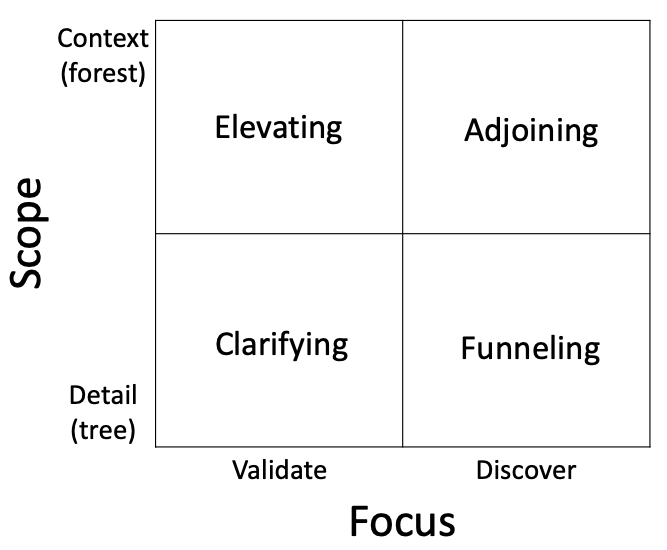The kick-ass framework for every Product Manager
In my previous post, I had shared my story of how my manager taught me the greatest ‘a-ha’ lesson of my professional life. 👇🏻
My first ‘aha’ learning of my career
TL;DR — The stakeholders are mostly clueless about their own needs, and they are totally allowed to be so. As a Product Manager, it is completely my responsibility to extract user needs by asking probing questions, by inspiring them to think and discover their needs. That is why it is called elicitation.
It appears, therefore, that asking questions is an art-form that we must master to have any hope to succeed in a Product Manager role.
I’m eager to share with you five types of questions and a framework for deciding which type of question must be used in what kind of situations.
So, without further ado, let’s dive in.
This framework is adapted from the 2015 Harvard Business Review article authored by Tom Pohlmann and Neethi Mary Thomas
Five types of questions
There are the following five types of questions, actually six.

Everyone knows what open and close ended questions are. Open/Close question-type is the foundation on which the other five types rest.
Clarifying Questions
Clarifying questions help elicit more detail or dig deeper into a specific topic. For example:
- Could you explain the business rule with an example?
- You said that the customer must call again to raise a release. What is this release, please?
- You said you run this process every week. Which specific day or days in the week?
- What do you mean “page should load quickly”? Is it less than 1 sec?
Funneling Questions
Funneling questions start with broad, open questions and build on the responses by asking narrower, more specific questions. For example:
Q: What is the problem that you are facing at your restaurant?
A: I think my customers are dissatisfied
Q: Why do you think your customers are dissatisfied?
A: Because of the long wait time before they are allotted a table to occupy
Q: What makes the wait time so long that they have to be dissatisfied?
A: The table turnover is pretty slow. It takes a long time for the customers already at the table to vacate the same.
Q: What contributes to the slow table turnover?
A: The waiters take a long time to generate the check
Q: Why does it take a long time to generate the check?
A: Because waiters have to generate the check manually
Elevating Questions
Elevating questions help stakeholders zoom out when you find them immersed in details, and fail to see the larger context. It helps you raise broader issues. For example:
- Are we even addressing the right problem?
- Let’s take a step back. What is the real issue?
- What are the larger trends that are at play here?
- What is the business benefit of having this feature?
- Why do you think having this drop down field on the search screen will help?
Adjoining Questions
Adjoining questions help you understand the related aspects of a problem that are ignored during the elicitation session. Adjoining questions are exploratory in nature, and helps us gain a broader understanding of the subject matter. For example:
- Are there any other areas where the same issue is applicable?
- Where else can we use the same solution?
- Is there anyone else who is impacted by this requirement?
- If you could change three things in the existing process to make it more efficient, what would they be?
Leading / Rhetorical Questions
Leading questions help you lead the stakeholders to your line of thought. For example:
- A google-like search capability is really what you need here, isn’t it? — leading the stakeholder to believe that this what they need.
- Do you think that user interface of this system is providing you with the exceptional user experience that you were expecting? — leading the stakeholder to answer yes or no depending upon the tone you used to ask this question
Rhetorical questions are those that don’t really expect any response.
- Why would anyone not like this feature in the system?
- How could no one think of this issue?
Leading and rhetorical questions need to be used carefully and sparingly. They do not offer you much in eliciting the needs of the stakeholders. It helps in pushing your opinion on the stakeholders.
The Framework
Leaving aside the leading/rhetorical questions, let’s slot the remaining four types of questions in a framework. The following 2×2 grid indicates what type of questions should primarily be used in what kind of interaction with stakeholders
The scope of a specific interaction with the stakeholders could be strategic or detailed.
The focus of the interaction could either be to discover or to validate what we already know.
The framework is simple and is pretty self-explanatory.

I have extensively used this framework to prepare for every stakeholder interaction.
The related advantage of this framework is that it forces us to nail down the scope and focus of our interaction. It forces us to ask — what is the purpose of this interaction? — a point when not asked, invariably leads to a failed meeting.
Thanks for reading. Hope you too will find this framework useful.
If you liked this piece, do share it in your professional network. Thanks much!
Chao! Have a great rest of the week!
The 5 types of Questions was originally published in UX Collective on Medium, where people are continuing the conversation by highlighting and responding to this story.